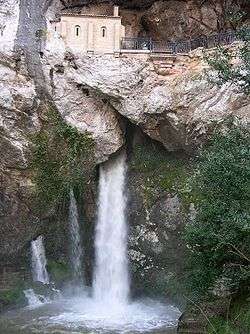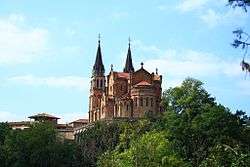Santa Cueva de Covadonga

The Santa Cueva de Covadonga (English: Holy Cave of Covadonga) is a Catholic sanctuary located in Asturias, northern Spain. It is a cave in the Picos de Europa mountains, which gives its name to the parish of Covadonga in the municipality of Cangas de Onís. The meaning of "Covadonga", from the Latin Cova Dominica is "Cave of the Lady", because the place is dedicated to the cult of the Virgin of Covadonga.
Description and history
The origin of the cave as place of cult is controversial. It seems to have been originally another place of confluence of Pagan Cult (in this case a fountain and cave together, seen as holy sites) as the Wilweorthunga had been in Prehistorical times and still during the Roman Empire occupation. The Christian tradition has it that Pelagius, chasing a criminal, who had taken refuge in the cave, meets a hermit who was worshiping the Virgin Mary. The hermit asked Pelagius to forgive the criminal, since the criminal had resorted to the protection of the Virgin, and says that one day that he too would need to seek shelter in the Cave. Some historians say the most plausible is that Pelagius and the Christians refugees in the Cave of the Muslims, they will bring them an image of the Virgin and leave her there after his victory at the Battle of Covadonga, the origin of the Reconquista.
Muslim chronicles about the Battle of Covadonga say that in this cave fled Pelagius forces, feeding on honey bees left in the crevices of the rock. Christian chronicles claim that the miraculous intervention of the Virgin Mary was crucial in the victory, repelling attacks against the cave.
The first construction in the Holy Cave dates back of the reign of Alfonso I of Asturias, who, to commemorate the victory of Pelagius to the Muslims, built a chapel dedicated to the Virgin Mary, that would give rise to the invocation of the Virgin of Covadonga (popularly known as La Santina). In addition to the altar to the Virgin built other two for Saint John the Baptist and Saint Andrew. Alfonso make delivery of this church to the Benedictine monks.
The cave was covered with wood, and in 1777 a fire destroyed the original carve of la Santina. The current carve is of 16th century and was donated to the Sanctuary by the Cathedral of Oviedo in 1778. The carving of the Virgin is painted wood, sweet features, holds the Child and a golden rose.
During the civil war the Virgin image disappears and is found in the Embassy of Spain in France in 1939. The present chapel of Romanesque style is work of Luis Menéndez-Pidal and Alvarez.
Royal pantheon of Covadonga
The shrine of Covadonga was very important for the early Christian kingdoms in the Iberian peninsula. The royal people that were buried in the Pantéon Real de Covadonga (English: Royal Pantheon (or Mausoleum) of Covadonga), were the following:
- Pelagius of Asturias (died 737). First king of Asturias and son of Duke Favila.
- Queen Gaudiosa, Pelagius's wife.
- A sister of the King Pelagius.
- Alfonso I of Asturias (693-757). Third king of Asturias, son of Peter of Cantabria, Duke of Cantabria.
- Queen Ermesinda. Alfonso I's wife, daughter of King Pelagius and Queen Gaudiosa, and sister of the King Favila of Asturias.
Pelagius died in Cangas de Onís, where he had his court in 737. After his death, his body was buried in the Church of Santa Eulalia of Abamia, located in the Asturian town of Abamia, where his wife had been also previously buried. The chronicler Ambrosio Morales noted in his work that Alfonso X the Wise, king of Castile and Leon, ordered to move the remains of Pelagius and his wife to the Holy Cave of Covadonga.
See also
References
External links
Coordinates: 43°18′32″N 5°03′23″W / 43.3089°N 5.0564°W
